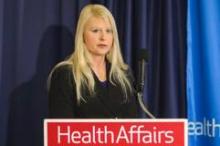WASHINGTON - Spending for physician services grew half a percentage point more in 2012 than 2011, according to an annual analysis of health care spending from the National Health Expenditure Accounts Team at the Centers for Medicare and Medicaid Services.
The uptick in spending growth was partially attributable to more physician visits as American pocketbooks began to rebound from the recent recession, Anne B. Martin and her colleagues at the CMS Office of the Actuary said at a briefing Jan. 6.
The impact of the Affordable Care Act on spending growth remained negligible in 2012, as it was in the two prior years, according to their analysis, published simultaneously in the journal Health Affairs (2014;33:67-77 [doi 10/1377/hlthaff.2013.1254]).
The CMS actuaries estimated that, overall, the law increased spending by 0.1% from 2010 to 2012. A few ACA provisions – such as coverage for dependents under age 26 and for patients with pre-existing conditions – increased spending, while others – such as payment cuts to hospitals and rebates for drugs under Medicaid – decreased spending.
Overall, the nation’s health spending – $2.8 *trillion in 2012, the most recent year for which there are accurate and complete data – grew 3.7% in 2012, a historically low rate similar to that seen in the previous 3 years. The flat spending reflects trends seen over the years, in particular with the last three boom-and-bust cycles of the economy, said the CMS actuaries. That is, when the economy does well, health spending rises. When there is a recession, health spending decreases; the rebound in spending often lags an economic recovery by several years, said Aaron Catlin, deputy director of the National Health Statistics Group in the Office of the Actuary.
Certain categories of spending did see growth increases or decreases in 2012 that were the result of one-time events, they said.
Spending on physician services by all payers grew by 4% to $452 billion in 2012. While still not approaching the 5.3% increase in 2008, it’s a rebound from just over 3% growth in 2009 and 2010. Physician services grew 3.5% in 2011 and the upward trend continued in 2012 "primarily because of an increase in visits to doctors’ offices as the economy continued to recover from the recent severe economic recession," Ms. Martin said.
Consumers are shouldering a growing share of their health costs, especially for physician services. Out-of-pocket spending on deductibles and copays grew by 3.8% in 2012. The amount Americans spent on health care, including premiums for private insurance and Medicare, and copays, deductibles, and other uncovered costs, grew 4.3% in 2012, compared to 3.1% in 2011.
Medicare, on the other hand, clamped down on physician pay rates and the volume of care it paid for, even as enrollment grew 4.1% in 2012 – the largest 1-year increase in enrollment in 39 years.
That enrollment growth helped drive an uptick in overall spending on hospital services, which is the largest category of national health expenditures, eating up 32% of the total pie. Hospital spending increased 4.9% in 2012 to $882 billion.
Medicaid spending in 2012 continued a pattern of historically low growth, in part because of slower enrollment as the economy rebounded and also as states continued efforts to rein in the program’s costs. Overall, the Medicaid tab was $421 billion in 2012.
Finally, growth in prescription drug spending slowed precipitously for all Americans – from 2.5% in 2011 to 0.4% in 2012 – even as the number of dispensed prescriptions grew by 1.4%, compared to only a 0.5% increase in 2011. The actuaries noted that this slowing was due in large part to the expanded use of generic drugs. Three top sellers went off patent in late 2011 and 2012: atorvastatin (Lipitor), clopidogrel (Plavix), and montelukast (Singulair). Generic drugs accounted for 77% of all dispensed prescriptions in 2012.
The authors disclosed no relevant conflicts of interest and noted that opinions expressed are their own and not necessarily those of the CMS.
On Twitter @aliciaault
*CORRECTION 1/13/14: A previous version of this article incorrectly reported the cost of the nation's overall health spending. This article has been updated.


